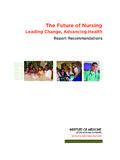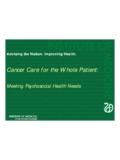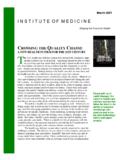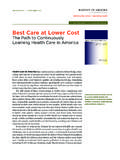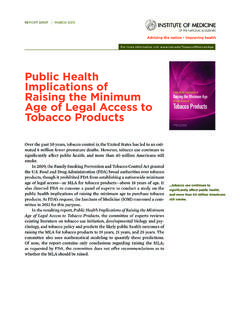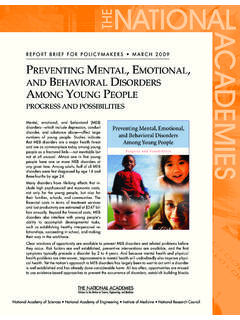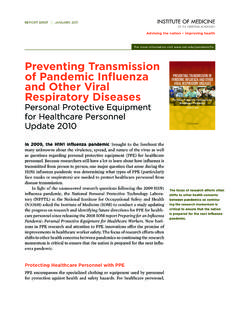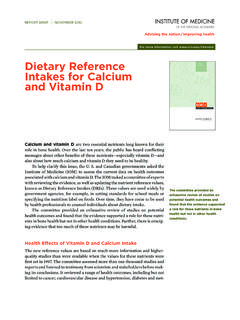Transcription of To Err is Human: Building a Safer Health System. Summary
1 November 1999 I N S T I T U T E O F M E D I C I N E Shaping the Future for Health TO ERR IS human : Building A Safer Health SYSTEM Health care in the United States is not as safe as it should be--and can be. At least 44,000 people, and perhaps as many as 98,000 people, die in hospitals each year as a result of medical errors that could have been prevented, according to estimates from two major studies. Even using the lower estimate, preventable medical errors in hospitals exceed attributable deaths to such feared threats as motor-vehicle wrecks, breast cancer, and AIDS. Medical errors can be defined as the failure of a planned action to be completed as intended or the use of a wrong plan to achieve an aim. Among the problems that commonly occur during the course of providing Health care are adverse drug events and improper transfusions, surgical injuries and wrong-site surgery, suicides, restraint-related injuries or death, falls, burns, pressure ulcers, and mistaken patient identities.
2 High error rates with serious consequences are most likely to occur in intensive care units, operating rooms, and emergency departments. Beyond their cost in human lives, preventable medical errors exact other significant tolls. They have been estimated to result in total costs (in cluding the expense of additional care necessitated by the errors, lost income and household productivity, and disability) of between $17 billion and $29 billion per year in hospitals nationwide. Errors also are costly in terms of loss of trust in the Health care system by patients and diminished satisfaction by both patients and Health professionals. Patients who experience a long hospi tal stay or disability as a result of errors pay with physical and psychological discomfort.
3 Health professionals pay with loss of morale and frustration at not being able to provide the best care possible. Society bears the cost of er rors as well, in terms of lost worker productivity, reduced school attendance by children, and lower levels of population Health status. A variety of factors have contributed to the nation s epidemic of medi cal errors. One oft-cited problem arises from the decentralized and frag mented nature of the Health care delivery system--or nonsystem, to some observers. When patients see multiple providers in different settings, none of whom has access to complete information, it becomes easier for things to go costly in terms of loss of trust in the Health care system by pa tients and dimin ished satisfaction by both patients and Health profes sionals.
4 Types of Errors Diagnostic Error or delay in diagnosis Failure to employ indicated tests Use of outmoded tests or therapy Failure to act on results of monitoring or testing Treatment Error in the performance of an operation, procedure, or test Error in administering the treatment Error in the dose or method of using a drug Avoidable delay in treatment or in responding to an abnormal test Inappropriate (not indicated) care Preventive Failure to provide prophylactic treatment Inadequate monitoring or follow-up of treatment Other Failure of communication Equipment failure Other system failure SOURCE: Leape, Lucian; Lawthers, Ann G.; Brennan, Troyen A., et al. Pr e-venting Medical Injury. Qual Rev Bull. 19(5):144 149, 1993. wrong. In addition, the processes by which Health professionals are licensed and accredited have focused only limited attention on the prevention of medical er rors, and even these minimal efforts have confronted resistance from some Health care organizations and providers.
5 Many providers also perceive the medical liabil ity system as a serious impediment to sys tematic efforts to uncover and learn from errors. Exacerbating these problems, most third-party purchasers of Health care pro-vide little financial incentive for Health care organizations and providers to im prove safety and quality. Health Care System at Odds with Itself The Quality of Health Care in America Committee of the Institute of Medicine (IOM) concluded that it is not acceptable for patients to be harmed by the Health More commonly, errors are caused by faulty systems, processes, and conditions that lead people to make mistakes or fail to prevent them. care system that is supposed to offer healing and comfort--a system that promises, First, do no harm.
6 Helping to remedy this problem is the goal of To Err is Hu man: Building a Safer Health System, the IOM Committee s first report. In this report, issued in November 1999 , the committee lays out a compre hensive strategy by which government, Health care providers, industry, and con sumers can reduce preventable medical errors. Concluding that the know-how already exists to prevent many of these mistakes, the report sets as a minimum goal a 50 percent reduction in errors over the next five years. In its recommenda tions for reaching this goal, the committee strikes a balance between regulatory and market-based initiatives, and between the roles of professionals and organi zations. One of the report s main conclusions is that the majority of medical er rors do not result from individual recklessness or the actions of a particular group--this is not a bad apple problem.
7 More commonly, errors are caused by faulty systems, processes, and conditions that lead people to make mistakes or fail to prevent them. For example, stocking patient-care units in hospitals with certain full-strength drugs, even though they are toxic unless diluted, has re sulted in deadly mistakes. Thus, mistakes can best be prevented by designing the Health system at all levels to make it Safer --to make it harder for people to do something wrong and easier for them to do it right. Of course, this does not mean that individuals can be careless. People still must be vigilant and held responsible for their actions. But when an error occurs, blaming an individual does little to make the system Safer and prevent someone else from committing the same error.
8 2 Strategy for Improvement To achieve a better safety record, the report recommends a four-tiered approach: Establishing a national focus to create leadership, research, tools, and protocols to enhance the knowledge base about safety. Health care is a decade or more behind many other high-risk industries in its attention to ensuring basic safety. This is due, in part, to the lack of a single designated government agency devoted to improving and monitoring safety throughout the Health care delivery system. Therefore, Congress should create a Center for Patient Safety that would set national safety goals and track progress in meeting them; develop a research agenda; define prototype safety systems; de velop, disseminate, and evaluate tools for identifying and analyzing errors; de velop methods for educating consumers about patient safety; and recommend ad ditional improvements as needed.
9 Funding for the center should be adequate and secure, starting with $30 million to $35 million per year and growing over time to at least $100 million an nually--modest investments relative to the consequences of errors and to the re-sources devoted to other public safety issues. The center should be housed within the Agency for Healthcare Research and Quality (AHRQ), which already is in volved in a broad range of quality and safety issues, and has established the infra structure and experience to fund research, education, and coordinating activities. Identifying and learning from errors by developing a nationwide public mandatory reporting system and by encouraging Health care organi zations and practitioners to develop and participate in voluntary reporting systems.
10 Under the mandatory reporting system, state governments will be required to collect standardized information about adverse medical events that result in death and serious harm. Hospitals should be required to begin reporting first, and eventually reporting should be required by all Health care organizations. This system will ensure a response to specific reports of serious injury, hold Health care organizations and providers accountable for maintaining safety, provide incen tives to organizations to implement internal safety systems that reduce the likeli hood of errors occurring, and respond to the public s right to know about patient safety. Currently, about a third of the states have mandatory reporting require ments. Voluntary reporting systems will provide an important complement to the mandatory system.
